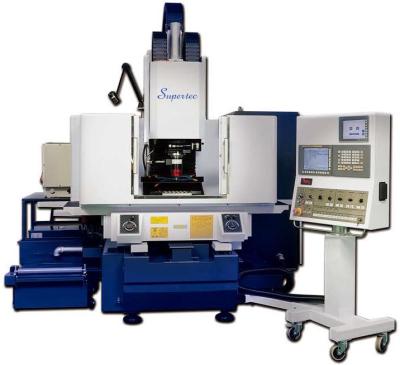
Supertec introduces three sizes of jig grinders covering a full range of capability. Models offered include the pictured JG-510M (20” x 12” x 4” x 13” X,Y,Z,W), the JG-1270CM (47” x 27” x 4” x 16”) and the JG-1010G (39” x 39” x 10” x 16”), a double-column style.
The JG-510CM model has an X- and Y-axis positioning accuracy of ±0.000060” and a planetary grinding roundness of 0.00004”. The Z-axis is driven by a high-speed linear motor for faster acceleration and greater repeatability.
All models utilize the FANUC 31i-B control for 4-axis simultaneous movement with 12 grinding modes including user friendly automatic pecking macros.
A KSK brand German-made hydrostatic spindle with an rpm up to 60,000 is used for greater accuracy and reliability. Air spindles for speeds up to 150,000 rpm are available based on application.
Contact Details
Related Glossary Terms
- grinding
grinding
Machining operation in which material is removed from the workpiece by a powered abrasive wheel, stone, belt, paste, sheet, compound, slurry, etc. Takes various forms: surface grinding (creates flat and/or squared surfaces); cylindrical grinding (for external cylindrical and tapered shapes, fillets, undercuts, etc.); centerless grinding; chamfering; thread and form grinding; tool and cutter grinding; offhand grinding; lapping and polishing (grinding with extremely fine grits to create ultrasmooth surfaces); honing; and disc grinding.
- jig
jig
Tooling usually considered to be a stationary apparatus. A jig assists in the assembly or manufacture of a part or device. It holds the workpiece while guiding the cutting tool with a bushing. A jig used in subassembly or final assembly might provide assembly aids such as alignments and adjustments. See fixture.
- linear motor
linear motor
Functionally the same as a rotary motor in a machine tool, a linear motor can be thought of as a standard permanent-magnet, rotary-style motor slit axially to the center and then peeled back and laid flat. The major advantage of using a linear motor to drive the axis motion is that it eliminates the inefficiency and mechanical variance caused by the ballscrew assembly system used in most CNC machines.
